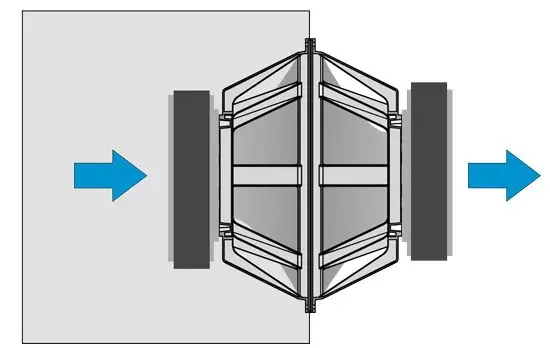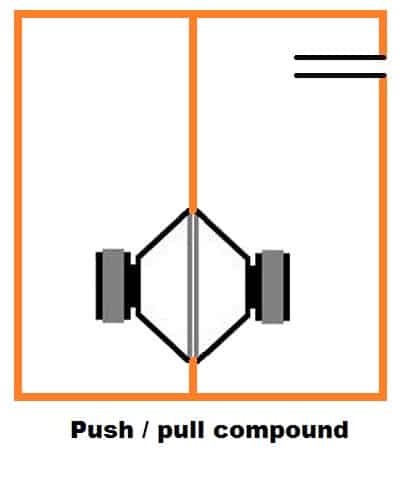Push-Pull is a term you will often come across when it comes to DIY subwoofers. This is a rather popular configuration with suspiciously low information on the internet.
So, what is a push-pull subwoofer?
Push Pull Subwoofer is a configuration where two drivers are mechanically opposed. In other words, one driver shows the cone, and the other shows the motor. Furthermore, one pulls in while the other pushes, hence the name push-pull subwoofer.
I know that wasn’t enough to satiate your curiosity. But I have at least covered the very basics in this article. Stay with me to find out more!
How Does Push Pull Subwoofer Work?
Push Pull Subwoofer works by using two of the same drivers, which are mechanically opposite. One pushes while the other pulls, one has a positive excursion while the other has a negative incursion.

Taking another step into the depths, in an Isobaric configuration, two drivers function together with shared air pressure. Push-pull is one variant of Isobaric configuration where two drivers are adjoined by a baffle cone to cone.
This results in a few advantages and a plethora of disadvantages as well. Let’s talk a little about the advantages.
What are the Advantages of Push Pull Subwoofers?
The advantages of push-pull subs are significantly lower non-linear distortion, improved thermals, and improved efficiency. Aside from that, it looks aesthetically pleasing as well to some folks.
Push-pull is not a very modern method, and most companies don’t use this configuration. However, this is the most popular Isobaric configuration for DIY subwoofers.
Low Harmonic Distortion:
Push-pull configurations typically use two drivers in the same enclosure. So, they cancel out each other’s non-linear distortion and ultimately lower the harmonic distortion significantly.
To be more specific, one cone is in positive excursion and another is in negative excursion which cancels out the nonlinear distortion.
Furthermore, As a result of the reduction in non-linear distortion, there’s an improvement in the linearity.
Improved Thermals:
Since two drivers will essentially share the power, each driver will effectively get half power. So the heat will not be trapped in a single section of the enclosure. Rather, it will be distributed in two sections, improving the thermal handling of the system as a whole.
These are the advantages of push-pull subwoofers. In my opinion, this is very niche. As only people who need sub performance in lower space for some reason can appreciate push-pull subs.
Can You Build Push Pull Subwoofers?: Basic Knowhows
Yes, you can build push-pull subwoofers. However, the process is tedious and vastly varies depending on the kind of enclosure you want.
So, I’ll just help you dabble your fingers in the basics for now. First of all, unlike the VBSS subwoofer, push-pull subwoofers have a lot of small parameters.
To familiarize yourself with these relevant terms for this build, I’ve included some parameters. Knowing these will help you get into the building part easily.
Thiele (Small Parameters):
From the get-go: Fs, Qts, and Vas are absolutely necessary knowledge to have for building a push-pull subwoofer. Here’s a short briefing on these terms-
Fs (Resonance Frequency):
Fs, or in other words, the resonance frequency, is the frequency where the driver moves with minimal effort. If the frequency goes below the resonance frequency, that’s where the roll-off begins.
So, the lower Fs, the better, especially for subwoofers.
Qts (Total Damping Factor):
Qts is the total damp factor. In other words, It is the addition of the electrical damp factor and mechanical damp factors. The formula for this is 1/Qts = 1/Qms + 1/Qes.
Q is the damping factor of a subwoofer. Damping is the characteristic of a sub that allows it to return to its rest state. In other words, this characteristic will enable the sub to stop moving after a beat.
Vas (Volume of Air inside the Cabinet):
Like its name, Vas is the air that is already present in the enclosure where you want to build the sub. The compliance of this air should match the Subwoofer’s compliance for best performance.
This ultimately defines the size of the enclosure you need to build.
That’ll be all about the small parameters. There are more, but knowing these will mark the starting line for you. Let’s now move on to finding the right design for your push-pull subwoofer.
Push Pull Subwoofer Box Design:
The 5 types of enclosure for push-pull subwoofers are Sealed Enclosure, Vented Enclosure, Bandpass 4th Order, Bandpass 6th order, and Bandpass 8th order. There are more variants in between, but these are the basics.
Sealed Enclosure:
This is the most common type of enclosure used for push-pull subwoofers. There is no vent in this configuration, and it is also the simplest to build.
The advantages of the sealed enclosure are- the small space required, easy build & design, decent power handling, and good transient response.
However, all these advantages come at the cost of efficiency. In this configuration, there are two drivers in a sealed box with a baffle in between. You can safely use this configuration due to the better thermal handling.
I personally would not recommend this configuration.
Vented Enclosure:
As per the name, this sort of enclosure includes a vent in it. It is another popular configuration for DIY push-pull subwoofers.
The advantages are- a well-balanced setup, high efficiency, access to lower frequencies, and lowered distortion.

However, it is more challenging to design than sealed enclosures and lacks transient response. Furthermore, it takes up more space as well.
With that out of the way, let’s move on to the bandpass.
Bandpass:
The most difficult design out of the bunch is the Bandpass design. There are three primary types of Bandpass designs- Bandpass 4th order, Bandpass 6th order, and Bandpass 8th order.
In bandpass configurations, the 4th order has one driver sealed and another in a ported enclosure. While the 6th order has 2 ports and the 8 order has 3. This comes with many advantages.
Namely, high efficiency, low excursion, and support for SPL applications. But the disadvantages are severe for these configurations.
For starters, Bandpass configurations are extremely hard to design, and they have no space for error at all. You also cannot tell if you’re overdriving these subs and may kill them.
In my opinion, the best-sounding subwoofer box design for starters would be the sealed enclosure. Because it is the easiest to design and requires minimal effort for it to sound good.
Another focal point of designing the push-pull enclosures is the calculation. There are specific methods of calculation for specific enclosures. You primarily have to calculate the sensitivity and impedance for your build to reach the optimal solution.
Push Pull Subwoofer Wiring:
The push-pull subwoofer should be wired out of phase. Wiring for subwoofers is generally simple and that trend continues in push-pull as well. The only difference is in the phase.
If this part goes wrong, your subwoofer might even sound muffled. So be careful with the wiring.
Are Push Pull Subwoofers Worth it?
No, the push-pull subwoofers are not worth it in my opinion. While these are aesthetically pleasing, they are just not worth it for most folks because of how hard they are to design.
However, that changes if you have some leftover drivers and want to find a good use for them. Then the utility extends from purely aesthetic to even professional streaming applications (SPL).
Are Push Pull Subwoofers Still Popular?
No, Push Pull Subwoofers are not popular now. While Push Pull Subwoofers were undeniably popular in the past, they are past their glory now since more advanced technology exists now.
However, Push-pull subwoofers still get attention in certain DIY niche communities. Now I’ll answer some of your questions before finally concluding the article.
Read also: Is IMAX Worth it? A Complete Review
Frequently Asked Questions (FAQs):
Are Push Pull Subwoofers Waterproof?
No, push-pull subwoofers are not waterproof. That’s because even in sealed enclosures, water gets in easily as these are not generally waterproofed. However, you can choose to waterproof sealed enclosures.
Do Push Pull Subwoofers Last Long?
Yes, push-pull subwoofers do last long if you take proper care. They are just like normal subwoofers in this regard. Though, this is older tech.
Can I use Two Different Sized Drivers for Making a Push-Pull Subwoofer?
No, you cannot use two different-sized drivers for making a push-pull subwoofer. You must use two of the same drivers. Otherwise, you may use one driver and one or more passive radiators.
Read also: RCA Home Theater Projector
Final Words
That’ll be it, folks! I hope this article at least helped you cover the basics of push pull subwoofers. Only a little more research and you’ll be ready to go for building yourself a push-pull subwoofer as well!
So, do you want to build a push-pull subwoofer yourself? Let me know in the comments below.
Till then!
Read also: Cinemark Vs AMC
